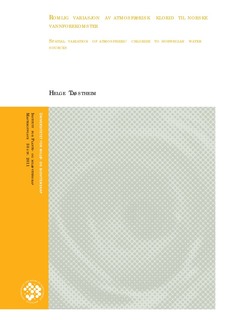Romlig variasjon av klorid til norske vannforekomster
Master thesis
Permanent lenke
http://hdl.handle.net/11250/189403Utgivelsesdato
2011-10-14Metadata
Vis full innførselSamlinger
- Master's theses (IPM) [204]
Sammendrag
En økt tilførsel av natriumklorid (NaCl) til innsjøer via veisalting, vil påvirke innsjøers kjemiske og fysiske egenskaper, som igjen vil ha en effekt på akvatisk biota. En rekke innsjøer i Norge får årlig tilført store mengder NaCl via veisalting. Hvor stor andel av en innsjøs totale NaCl tilførsel representerer dette antropogene bidraget med NaCl, i forhold til det naturlige bidraget som tilføres innsjøer via nedbør?
Med bruk av data fra NILU og NVE, har den romlige kloridkonsentrasjon i nedbør over Norge blitt estimert. Den ble beregnet til å ligge mellom 0 – 4,5 mg/l. Fra dette har kloridkonsentrasjonen i grunnvannet blitt beregnet. For å få det til ble en korreksjonsfaktor som tok hensyn til oppkonsentrering av salt via evapotranspirasjon beregnet. Kloridkonsentrasjonen i grunnvannet ble beregnet til å ligge mellom 0 og 8 mg/l. Som forventet var det en klar trend med de høyeste konsentrasjonene nær kysten, både i nedbør og grunnvann.
Den beregna kloridkonsentrasjonen i grunnvannet ble sammenlignet med målinger av kloridkonsentrasjoner i 2427 grunnvannsbrønner fordelt utover Norge. Differansen mellom beregnet og målt kloridkonsentrasjon i grunnvannet, ga et estimat på hvor stor andel av den totale kloridkonsentrasjonen i grunnvannet som kom fra nedbør, og ga også et bilde av hvor i landet andre kloridkilder som veisalt og marine sedimenter gjør seg gjeldende.
Med bruk av data fra Vegvesenet ble veisaltets årlige kloridbidrag til naturen kvantifisert og sammenlignet med den mengden klorid som kommer fra nedbør. For vinteren 2009/2010 sto veisalt for rundt 10 % sammenlignet med bidraget fra nedbøren. Preliminære tall for veisaltforbruket fra sist vinter (vinteren 2010/2011), tyder på at denne prosentandelen vil stige. En fortsatt økende trend i bruken av veisalt vil kunne medføre langt større konsekvenser for resipienter og akvatisk biota i tiden som kommer. Abstract
Increases in the level of sodium chloride (NaCl) in lakes, caused by road salt, will affect the
chemical and physical properties of lakes. This will in turn affect the aquatic biota. Road salt
contributes annually large quantities of NaCl to a number of lakes in Norway. What share of a
lake’s total level of NaCl does this anthropogenic contribution stand for, compared to the
natural contribution of NaCl from precipitation?
Using data from NILU and NVE, the spatial chloride concentration in precipitation over
Norway has been estimated as being in the range of 0 – 4.5 mg/l. Furthermore the chloride
concentration in groundwater was calculated. To achieve this, a correction factor which took
into account the concentrating of salt via evapotranspiration was calculated. The chloride
concentration in groundwater was estimated to be in the range of 0 – 8 mg/l. As expected, a
clear trend was discovered, with the highest concentrations of chloride found near the coast,
both with regard to precipitation and groundwater.
The estimated chloride concentration in groundwater was compared with measurements of
chloride concentrations in 2427 groundwater wells, distributed throughout Norway. The
difference between the calculated and the measured chloride concentration in the groundwater
gave an estimate of the proportion of the total chloride concentration in groundwater coming
from precipitation and furthermore indicated areas of the country where other sources of
chloride, such as road salt, are most apparent.
Using data from the Public Road Administration the annual contribution to nature of chloride
from road salt was quantified and compared with the amount of chloride that comes from
precipitation. Compared to the contribution from precipitation, road salt stood for about 10 %
of the chloride level of lakes during the winter of 2009/2010. Preliminary data for the use of
road salt during the winter of 2010/2011, indicate that this percentage will rise. A continued
upward trend in the usage of road salt can lead to far greater consequences for recipients and
aquatic biota in the future.
